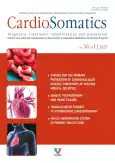Septal alcohol ablation in patients with hypertrophic cardiomyopathy and left ventricular outflow tract obstruction
- 作者: Nozdriakova M.S.1, Zalyubovsky D.A.1, Maznev D.S.1, Evdokimov D.S.1, Sergeev A.S.2, Shloydo E.A.3
-
隶属关系:
- Mechnikov North-Western State Medical University
- Multidisciplinary City Hospital № 2,
- Multidisciplinary City Hospital № 2
- 期: 卷 16, 编号 1 (2025)
- 页面: 76-83
- 栏目: Original study articles
- URL: https://journal-vniispk.ru/2221-7185/article/view/309738
- DOI: https://doi.org/10.17816/CS636702
- EDN: https://elibrary.ru/RIDRSN
- ID: 309738
如何引用文章
全文:
详细
BACKGROUND: Hypertrophic cardiomyopathy is a primarily genetically determined myocardial disease characterized by pronounced, often asymmetric, myocardial hypertrophy that results in diastolic dysfunction and left ventricular outflow tract obstruction. Septal alcohol ablation is a contemporary, minimally invasive interventional approach to the treatment of this condition.
AIM: To evaluate the effectiveness of septal alcohol ablation and the progression of heart failure in patients following the procedure.
MATERIALS AND METHODS: A single-group, open-label study was conducted to evaluate the outcomes of septal alcohol ablation in patients with hypertrophic cardiomyopathy and left ventricular outflow tract obstruction resistant to pharmacologic therapy. All patients were hospitalized at St. Petersburg City Multidisciplinary Hospital No. 2 between September 2021 and February 2024. Among the 157 patients diagnosed with hypertrophic cardiomyopathy, only 65 met the inclusion criteria. The effectiveness of septal alcohol ablation was assessed based on normalization of the peak pressure gradient in the left ventricular outflow tract and improvement in clinical status, evaluated at hospital discharge, three months’ post-procedure, and during a follow-up visit in February 2024.
RESULTS: A significant reduction in the peak pressure gradient in the left ventricular outflow tract was observed in postoperative patients following septal alcohol ablation — from 81.5 to 21.3 mm Hg (p=0.000001). Interventricular septal thickness decreased from 21.6 to 19.6 mm, left ventricular ejection fraction increased from 63.3 to 65.1%, and left ventricular end-diastolic diameter changed from 42.6 to 42.1 mm (p=0.62). No intraoperative complications such as coronary artery perforation, cardiac tamponade, or access site hematoma were reported. Major cardiovascular events within one year after septal alcohol ablation occurred in 12 patients (18.5%), including 9 cases (13.8%) of heart failure decompensation and 2 cases (3.1%) of myocardial infarction. A statistically significant improvement in New York Heart Association functional class was observed — from class III–IV to class I–II (p=0.0009).
CONCLUSION: Septal alcohol ablation has proven to be an effective and safe treatment modality for obstructive hypertrophic cardiomyopathy, provided that appropriate patient selection is ensured.
作者简介
Mariia Nozdriakova
Mechnikov North-Western State Medical University
Email: mariyanoz22@yandex.ru
ORCID iD: 0009-0001-3795-0347
SPIN 代码: 3647-2251
俄罗斯联邦, 41 Kirochnaya st, St. Petersburg, 191015
Dmitrii Zalyubovsky
Mechnikov North-Western State Medical University
Email: dmitrijzalubovskij@mail.ru
ORCID iD: 0009-0000-1909-5175
SPIN 代码: 2920-3583
俄罗斯联邦, 41 Kirochnaya st, St. Petersburg, 191015
Dmitriy Maznev
Mechnikov North-Western State Medical University
Email: fonmaznev@gmail.com
ORCID iD: 0000-0001-5486-5251
SPIN 代码: 7594-1896
MD, Cand. Sci. (Medicine)
俄罗斯联邦, 41 Kirochnaya st, St. Petersburg, 191015Dmitrii Evdokimov
Mechnikov North-Western State Medical University
编辑信件的主要联系方式.
Email: kasabian244@gmail.com
ORCID iD: 0000-0002-3107-1691
SPIN 代码: 5260-0063
俄罗斯联邦, 41 Kirochnaya st, St. Petersburg, 191015
Aleksei Sergeev
Multidisciplinary City Hospital № 2,
Email: rho-gmpb2@rambler.ru
ORCID iD: 0000-0002-3719-7869
SPIN 代码: 9281-1156
MD
俄罗斯联邦, St. PetersburgEugene Shloydo
Multidisciplinary City Hospital № 2
Email: rho-gmpb2@rambler.ru
ORCID iD: 0000-0001-8555-3023
SPIN 代码: 7661-8854
MD, Cand. Sci. (Medicine)
俄罗斯联邦, St. Petersburg参考
- Elliott P, Charron P, Blanes JRG, et al. European Cardiomyopathy Pilot Registry: EURObservational Research Programme of the European Society of Cardiology. Eur Heart J. 2016;37(2):164–173. doi: 10.1093/eurheartj/ehv497
- Healthcare in Russia. 2023: statistical collection. Moscow: Rosstat; 2023. P. 24–25. (In Russ.)
- Velieva LM, Dzhordzhykiya RK. Obstructive hypertrophic cardiomyopathy: historical aspects and modern methods of treatment (review). The Bulletin of Contemporary Clinical Medicine. 2020;13(2):55–62. doi: 10.20969/VSKM.2020.13(2).55-62 EDN: JYFSTC
- Gabrusenko SA, Gudkova AYa, Koziolova NA, et al. 2020 Clinical practice guidelines for Hypertrophic cardiomyopathy. Russian Journal of Cardiology. 2021;26(5):4541. doi: 10.15829/1560-4071-2021-4541 EDN: MXDYLE
- Scholtz S, Rudolph V, Reil J-C. Alcohol Septal Ablation or Mavacamten for Obstructive Hypertrophic Cardiomyopathy. J Clin Med. 2023;12(20):6628. doi: 10.3390/jcm12206628
- Gragnano F, Pelliccia F, Guarnaccia N, et al. Alcohol Septal Ablation in Patients with Hypertrophic Obstructive Cardiomyopathy: A Contemporary Perspective. J Clin Med. 2023;12(8):2810. doi: 10.3390/jcm12082810
- Nishimura RA, Seggewiss H, Schaff HV. Hypertrophic obstructive cardiomyopathy. Surgical myectomy and septal ablation. Circ Res. 2017;121:771–783 doi: 10.1161/CIRCRESAHA.116.309348
- Dzhordzhikiia RK, Volodiukhin MYu, Safarova DF, et al. Comparative assessment of different surgical treatment methods in obstructive hypertrophic cardio myopathy. Clinical and Experimental Surgery. Petrovsky Journal. 2020;8(3):51–58. doi: 10.33029/2308-1198-2020-8-3-51-58 EDN: DFFFQV
- Nikolaeva IE, Plechev VV, Mukhametyanov AM, et al. Contrast Enhanced Echocardiography-Controlled Alcohol Septal Ablation for Hypertrophic Cardiomyopathy with Left Ventricular Outflow Tract Obstruction. Creative Surgery and Oncology. 2019;9(2):132–137. doi: 10.24060/2076-3093-2019-9-2-132–137 EDN: YRVOKU
- Lang RM, Badano LP, Mor-Avi V, et al. Recommendations for Cardiac Chamber Quantification by Echocardiography in Adults: An Update from the American Society of Echocardiography and the European Association of Cardiovascular Imaging. J Am Soc Echocardiogr. 2015;28(1):1–39.e14. doi: 10.1016/j.echo.2014.10.003
- Veselka J, Jensen MK, Liebregts M, et al. Long-term clinical outcome after alcohol septal ablation for obstructive hypertrophic cardiomyopathy: results from the Euro-ASA registry. Eur Heart J. 2016;37(19):1517–1523. doi: 10.1093/eurheartj/ehv693
- Nagueh SF, Groves BM, Schwartz L, et al. Alcohol septal ablation for the treatment of hypertrophic obstructive cardiomyopathy a multicenter North American registry. J Am Coll Cardiol. 2011;58(22):2322–2328. doi: 10.1016/j.jacc.2011.06.073
- Kashtanov MG, Reitblat OM, Mishina MO, et al. Alcohol septal ablation and outcomes in patients with obstructive hypertrophic cardiomyopathy depending on outflow gradient and basal hypertrophy. Clinical and Experimental Surgery. Petrovsky Journal. 2024;12(1(43)):80–89. doi: 10.33029/2308-1198-2024-12-1-80-89 EDN: RDTLKF
补充文件












